Good Job!
You got 0 out of 21 right.
You've been an awesome assistant.
Thanks for all your help gathering clues about sauropods.

skull
Pick another Fossil

Kristi
Curry-Rogers
I examine the shape of dinosaur bones and compare them to other animals.
Kristi
ANATOMIST
Curry-Rogers
I examine the shape of dinosaur bones and compare them to other animals.

Mark Norell
I investigate how animals evolved and how they’re related.
Mark
SYSTEMATIST
I investigate how animals evolved and how they’re related.

Amy Balanoff
I analyze the structure of the brain and how it relates to an animal’s behavior.
Amy
ANATOMIST
I analyze the structure of the brain and how it relates to an animal’s behavior.

Amy Balanoff
I analyze the structure of the brain and how it relates to an animal’s behavior.
Amy
ANATOMIST
I analyze the structure of the brain and how it relates to an animal’s behavior.
Apatosaurus had a tiny brain. It was 12 times lighter than a human brain. If our brain weighs 48 ounces, what was the weight of an Apatosaurus brain?
Yup!
Nope!
The answer is:
60 ounces
24 ounces
4 ounces
This massive sauropod weighed about 25 tons. But its brain weighed only 4 ounces, about as heavy as an apple!
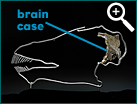
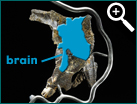
Sauropod skulls are usually 2 to 3 feet (0.6 to 1 m) long. This may seem big compared to our skull, but it's actually tiny compared to a sauropod's gigantic body, which can be over 70 feet (21 m) long!
What about the brains inside the skulls? Brains don’t fossilize. So we rely on parts of fossil skulls, like this braincase, for clues to sauropod brains.
What about the brains inside the skulls? Brains don’t fossilize. So we rely on parts of fossil skulls, like this braincase, for clues to sauropod brains.
Examine each dinosaur's brain volume compared to its body mass. Which of these dinosaurs do you think was the smartest?
Yup!
Nope!
The answer is:
Apatosaurus
Stegosaurus
Tyrannosaurus rex
Even though sauropods had tiny brains relative to their massive bodies, they were still smart enough to find food and herd their young.
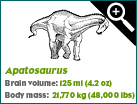
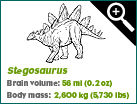
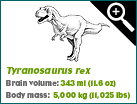
I can tell how smart an animal is by comparing the size of its brain to the size of its body. The bigger the brain compared to its body, generally the smarter the animal.
Also, plant eaters often have smaller brains than meat eaters. After all, their food doesn't try to escape!
Also, plant eaters often have smaller brains than meat eaters. After all, their food doesn't try to escape!
Which of these brains belonged to a sauropod?
Yup!
Nope!
The answer is:
A
B
Apatosaurus (A) had a nearly vertical brain. The other brain (B) belonged to a Tyrannosaurus. Its brain is horizontal, or sideways, in the skull, just like ours!
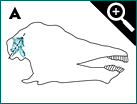
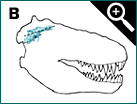
CT scanners are like 3-D x-ray machines. I use them to peer inside dinosaur skulls.
We can tell the shape and position of an animal’s brain based on the shape of the braincase. Sauropod brains were almost vertical, that is, they pointed up.
We can tell the shape and position of an animal’s brain based on the shape of the braincase. Sauropod brains were almost vertical, that is, they pointed up.
Examine the size of the pituitary glands. Which of these brains belonged to the sauropod?
Yup!
Nope!
The answer is:
A
B
In some sauropods, the pituitary made up 10% of the brain volume. That’s 50 times more than a human’s!
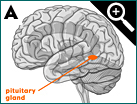
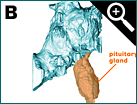
CT scans help us understand the structures of the brain. These scans highlight the pituitary gland in a human brain and a sauropod brain. This gland produces hormones, or natural chemicals, that control growth.
Bigger animals tend to have bigger pituitary glands relative to the size of the brain.
Bigger animals tend to have bigger pituitary glands relative to the size of the brain.
teeth
Pick another Fossil

Mark Norell
I investigate how animals evolved and how they’re related.
Mark
SYSTEMATIST
I investigate how animals evolved and how they’re related.

Martin Sanders
I examine bones and teeth to learn how animals moved, lived, and ate.
Martin
MORPHOLOGIST
I examine bones and teeth to learn how animals moved, lived, and ate.

Cathy Forster
I study the shape of bones and compare them to other animals.
Cathy
ANATOMIST
I study the shape of bones and compare them to other animals.

Mike D'Emic
I cut fossilized bones and teeth into thin slices and look at them under a microscope.
Mike
HISTOLOGIST
I cut fossilized bones and teeth into thin slices and look at them under a microscope.
Look at these teeth. Which two belonged to the sauropods?
Yup!
Nope!
The answer is:
A and B
B and C
A and C
The teeth of sauropods like Camarasaurus (A) and Diplodocus (B) were more rounded.
Those long, sharp teeth belonged to a Tyrannosaurus rex (C)!
Those long, sharp teeth belonged to a Tyrannosaurus rex (C)!
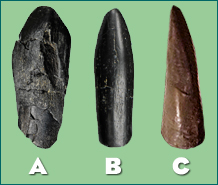
When I find a tooth in the field, I can tell right away whether the animal it belonged to ate plants or meat.
Meat eaters need really sharp teeth to catch prey and rip flesh.
Plant eaters like sauropods have more flattened teeth for snapping, stripping, or grinding plants.
Meat eaters need really sharp teeth to catch prey and rip flesh.
Plant eaters like sauropods have more flattened teeth for snapping, stripping, or grinding plants.
This Diplodocus tooth is pencil-shaped. What do you think this type of tooth was used for?
Yup!
Nope!
The answer is:
crushing and grinding plants
strippng leaves off branches
slicing big leaves into smaller pieces
Together, the Diplodocus teeth worked like a rake, just right for stripping leaves off branches. Two common plants that sauropods ate were horsetail and gingko. These were nutritious and widespread.
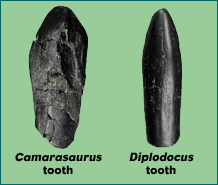
The shape of a dinosaur’s teeth doesn’t just tell us what it ate. It also tells us how it ate.
Take a look at the teeth of these two sauropods. The Camarasaurus tooth is spoon-shaped. We think these teeth were used for snapping branches.
Take a look at the teeth of these two sauropods. The Camarasaurus tooth is spoon-shaped. We think these teeth were used for snapping branches.
Examine the fossil. How many types of teeth does Camarasaurus have in its mouth?
Yup!
Nope!
The answer is:
one
two
three
Each sauropod had just one kind of teeth, and it was used only for scraping or snapping their food. Sauropods didn't bother chewing. They just got the food in their mouths quickly, and swallowed it whole!

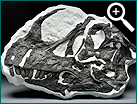
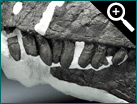
Humans have different types of teeth. We have sharp ones in the front for biting and ripping, and flat ones in the back for grinding and chewing. Think about the way you eat an apple: You use your front teeth to bite off a smaller chunk, and then chew it up with your back teeth before you swallow. Sauropods ate very differently than we do. They didn’t bother chewing! We know this from examining fossilized teeth, like the ones on this Camarasaurus skull.
Count the number of growth lines. How old is this tooth?
Yup!
Nope!
The answer is:
less than two weeks old
at least three weeks old
over two months old
Sauropods like Diplodocus replaced its teeth as often as once a month, and Camarasaurus about every 60 days. This might seem fast, but teeth wear down quickly when eating tough plants all day long!

After you lose your baby teeth, you’re stuck with the ones that grow back. But sauropods were constantly growing new teeth throughout their life. I can tell how often by counting “growth marks” under a microscope.
Take a look at this thin section of a dinosaur tooth. See those horizontal lines? Each line is a new layer of tooth. A layer formed every day, so there’s one line for each day.
Take a look at this thin section of a dinosaur tooth. See those horizontal lines? Each line is a new layer of tooth. A layer formed every day, so there’s one line for each day.
vertebra
Pick another Fossil

Mark Norell
I investigate how animals evolved and how they’re related.
Mark
SYSTEMATIST
I investigate how animals evolved and how they’re related.

Matt Wedel
I examine bones with CT scanners to explore their structure, strength, and weight.
Matt
ANATOMIST
I examine bones with CT scanners to explore their structure, strength, and weight.

Cathy Forster
I study the shape of bones and compare them to those of other animals.
Cathy
ANATOMIST
I study the shape of bones and compare them to those of other animals.
Count the number of neck vertebrae. Which animal has the most?
Yup!
Nope!
The answer is:
giraffe
Apatosaurus
Mamenchisaurus
As a mammal, even the long-necked giraffe has only 7 vertebrae in its neck. Sauropods had between 10 and 19. That's one of the reasons why they had the longest necks of any dinosaur known!

Most mammals, including humans and elephants, have just seven vertebrae in their necks.
But the number of vertebrae in a sauropod neck varies from species to species.
But the number of vertebrae in a sauropod neck varies from species to species.
The air pockets made these bones:
Yup!
Nope!
The answer is:
flexible
magnetic
strong, but light
These bones must have been very light, making it easier for sauropods to hold up and move their long necks!

With a CT scanner, I can get an inside look at the sauropod vertebrae.
See those yellow spots in this CT scan? Those are holes, or air pockets. This vertebra is mostly hollow!
Sauropod vertebrae were built very differently than giraffe or human vertebrae. Mammal bones are dense and heavy.
See those yellow spots in this CT scan? Those are holes, or air pockets. This vertebra is mostly hollow!
Sauropod vertebrae were built very differently than giraffe or human vertebrae. Mammal bones are dense and heavy.
What's an advantage of long necks in sauropods?
Yup!
Nope!
The answer is:
They could eat birds high in trees.
They could reach more plants.
They could breathe in more oxygen.
The longer a sauropod’s neck, the more food it could reach just standing in one place. They could gulp down a lot of plants without having to spend energy moving those huge bodies around!
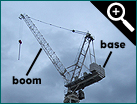
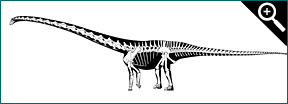
Long necks were a key reason sauropods were able to get so big.
You could compare a sauropod’s neck to a construction crane. Like the boom of the crane, a sauropod’s long neck can reach really far while its massive body, like the base of the crane, stayed in one place.
You could compare a sauropod’s neck to a construction crane. Like the boom of the crane, a sauropod’s long neck can reach really far while its massive body, like the base of the crane, stayed in one place.
ribs
Pick another Fossil

Kristi
Curry-Rogers
I examine the shape of dinosaur bones and compare them to other animals.
Kristi
ANATOMIST
Curry-Rogers
I examine the shape of dinosaur bones and compare them to other animals.

Matt Wedel
I examine bones with CT scanners to explore their structure, strength, and weight.
Matt
ANATOMIST
I examine bones with CT scanners to explore their structure, strength, and weight.

Patrick O'Connor
I compare fossils with modern animals to learn how the bodies of extinct animals worked.
Patrick
ANATOMIST
I compare fossils with modern animals to learn how the bodies of extinct animals worked.
Look closely at the Apatosaurus' ribs. Where do you think this sauropod lived?
Yup!
Nope!
The answer is:
swamps
deep oceans
land
Sauropods had thin ribs and most likely lived on land. If sauropods had lived in water, their ribs probably would have been very thick, like the manatee’s.
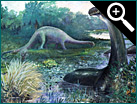
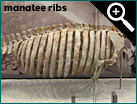
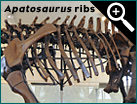
For a long time, scientists thought sauropods lived in swamps, where water could support their huge body weight. To test this idea, we can compare the ribs of sauropods and aquatic animals. Sea creatures have special adaptations for living in water. Take a look at a manatee's rib cage. It had thick, heavy ribs. Heavy bones keep animals from floating and help them dive for food more easily.
What do you think was another advantage of air sacs?
Yup!
Nope!
The answer is:
They could also hold food and water.
They made the sauropod lighter.
They helped sauropods breathe underwater.
A lot of space inside a sauropod's body would have been filled with air rather than flesh. These dinosaurs were still enormously heavy. But they were not as heavy as they might have been.

The rib cage protected a sauropod's lungs.
Some sauropods also had air sacs inside them. These large, air-filled pouches were part of a super-efficient breathing system. They helped moved air through the lung of sauropods.
Some sauropods also had air sacs inside them. These large, air-filled pouches were part of a super-efficient breathing system. They helped moved air through the lung of sauropods.
Which animal alive today has ribs that move this way?
Yup!
Nope!
The answer is:
bird
lizard
human
Sauropod ribs don’t just move the same way as living birds, they are also very similar in shape. Scientists think sauropods probably breathed in much the same way as living birds. That makes a lot of sense since birds are living dinosaurs.
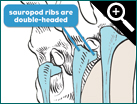
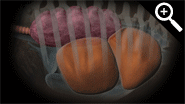
Ribs give us clues about how sauropods breathed.
Take a look at the head of a rib. See how it's double-headed? This shape allowed the ribs to move like door hinges. The ribs swung in and out as air flowed into and throughout the lung and air sacs.
Take a look at the head of a rib. See how it's double-headed? This shape allowed the ribs to move like door hinges. The ribs swung in and out as air flowed into and throughout the lung and air sacs.
femur
Pick another Fossil

Karen Moreno
I examine the size and shapes of bones to learn how an animal moved and behaved.
Karen
MORPHOLOGIST
I examine the size and shapes of bones to learn how an animal moved and behaved.

John Hutchinson
I study bones to find out about animals – like how they moved.
John
MORPHOLOGIST
I study bones to find out about animals – like how they moved.

Anusuya Chinsamy-Turan
I examine tissues like bones and teeth under a microscope.
Anusuya
HISTOLOGIST
I examine tissues like bones and teeth under a microscope.
How much do you think Argentinosaurus weighed?
Yup!
Nope!
The answer is:
8,374 kg (18,460 pounds)
51,374 kg (113,260 pounds)
81,374 kg (179,400 pounds)
That’s 90 tons! This sauropods would’ve weighed as much as 15 elephants. We figured out this formula using computer models based on sauropod skeletons.

I can estimate the weight of an entire sauropod based on just the length of its femur (thigh bone). How? With a mathematical formula:
(femur length in centimeters)3.2 x 0.0016 = body mass in kilograms
I used it to calculate the body mass of Europasaurus and Mamenchisaurus. Take a look.
(femur length in centimeters)3.2 x 0.0016 = body mass in kilograms
I used it to calculate the body mass of Europasaurus and Mamenchisaurus. Take a look.
Look at the skeleton of this Apatosaurus leg. How would you describe its speed?
Yup!
Nope!
The answer is:
fast
medium
slow
Sauropods’ femurs were longer than their tibias. They had quite straight legs and moved slowly, about 5 miles per hour. Humans need to jog to keep up that pace, but for such a massive animal, it’s just a stroll!

I can compare a dinosaur’s femur (thigh bone) to other bones to estimate how it moved, and how fast.
If an animal’s femur is longer than its tibia (shin bone), it probably stood more straight-legged and moved slowly.
If its tibia is longer than its femur, it probably moved faster.
If an animal’s femur is longer than its tibia (shin bone), it probably stood more straight-legged and moved slowly.
If its tibia is longer than its femur, it probably moved faster.
Why do you think bones don't show growth marks before adulthood?
Yup!
Nope!
The answer is:
Young sauropods grew too fast for these lines to form.
Young sauropods grew too slow for these lines to form.
Young sauropods do not eat enough for these lines to form.
Young sauropods grew very rapidly. Some gained up to 5,300 pounds (1,600 kg) a year! Their growth usually slowed around age 30, when they reached adulthood.

I can estimate a sauropod’s age by examining thin slices of femur under a microscope. Each slice is about half the thickness of a single strand of hair! See the lines? Each line is a “growth mark,” showing one year of adulthood. The space between the lines shows how much it grew in that year. So like the rings of a tree, they can be counted to reveal the age of the dinosaur. They also tell us how the animal grew.
eggs
Pick another Fossil

Luis Chiappé
I investigate eggs to learn how dinosaurs reproduced.
Luis
EMBRYOLOGIST
I investigate eggs to learn how dinosaurs reproduced.

Anusuya Chinsamy-Turan
I examine fossil bones, teeth, and eggshell under a microscope.
Anusuya
HISTOLOGIST
I examine fossil bones, teeth, and eggshell under a microscope.

Kristi
Curry-Rogers
I study the shape of dinosaur bones and compare them to other animals.
Kristi
ANATOMIST
Curry-Rogers
I study the shape of dinosaur bones and compare them to other animals.

Martin Sanders
I examine bones and teeth to learn how animals moved, lived, and ate.
Martin
MORPHOLOGIST
I examine bones and teeth to learn how animals moved, lived, and ate.
Which egg do you think was laid in mud or in a tightly-packed nest?
Yup!
Nope!
The answer is:
A
B
These eggs needed bigger and more pores. That made it easier for air and water vapor to flow in and out of the eggshell. Eggs laid in open, airy places like the desert needed fewer or smaller pores. They might dry out if too much water vapor escaped.
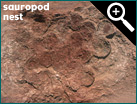
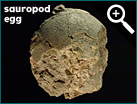
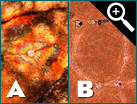
I’ve excavated hundreds of sauropod nests in Argentina. Many of the nests contained fossilized eggs. Back in the lab, I examine eggshells under a microscope. Take a look at the two eggshell images. Those dots are pores, or tiny holes. They allow air and water vapor to move in and out of the eggshell. The number and size of pores are clues about the environment in which a dinosaur laid its eggs. A shell with lots of pores or big pores means the eggs were probably laid in a wet or crowded environment.
The biggest sauropod eggs were about the size of a:
Yup!
Nope!
The answer is:
baseball
volleyball
large beach ball
Scientists calculate that no egg could weigh more than about 110 pounds (50 kg). Any bigger than that, and the eggshell would either be too thin to protect the embryo inside or too thick to let air and water pass through.

What does egg size tell us about the size of the adult? Not much!
It might seem logical that sauropods must have laid the biggest eggs of all. But an egg can get only so big. The larger it is, the thicker its shell has to be so it doesn’t crack. And the eggshell can’t be too thick, or air can’t pass through to help the embryo grow.
It might seem logical that sauropods must have laid the biggest eggs of all. But an egg can get only so big. The larger it is, the thicker its shell has to be so it doesn’t crack. And the eggshell can’t be too thick, or air can’t pass through to help the embryo grow.
Look at how fast this Mamenchisaurus grew from a hatchling to a 30-year-old. If a 7-pound newborn human grew this fast, how much would he or she weigh by the 30th birthday?
Yup!
Nope!
The answer is:
700 pounds
7,000 pounds
70,000 pounds
Mamenchisaurus grew from a 6-pound hatchling to a 13-tons adult.
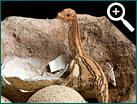
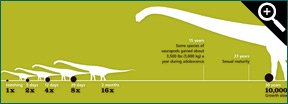
The eggs could only get so big, so sauropod hatchlings were small. They probably weighed less than 11 pounds (5 kg). That’s no bigger than a goose! These little hatchlings were easy prey for predators, so a lot of them didn't live to become adults. Luckily, there were so many eggs that some did survive. Those that did grew really, really fast. Some gained as much as 5,300 pounds (2,400 kg) a year!
Why do you think sauropod moms didn’t sit on their nests?
Yup!
Nope!
The answer is:
They were too heavy.
Their eggs were too big.
They let the sauropod dads sit on the nests.
Scientists have never found a fossil of sauropods tending their nests. They think that sauropods were so heavy, they would have broken the eggs!
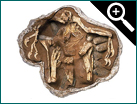
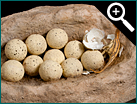
This is a fossil of an Oviraptor mom atop her eggs. It's evidence that these theropod dinosaurs sat on their eggs to protect them and keep them warm, just like birds living today.
But not the sauropods. Using their huge feet, they dug out shallow nests. After laying between 15 to 40 eggs, the mothers moved on. They didn't stay to incubate their eggs or care for the babies.
But not the sauropods. Using their huge feet, they dug out shallow nests. After laying between 15 to 40 eggs, the mothers moved on. They didn't stay to incubate their eggs or care for the babies.






















